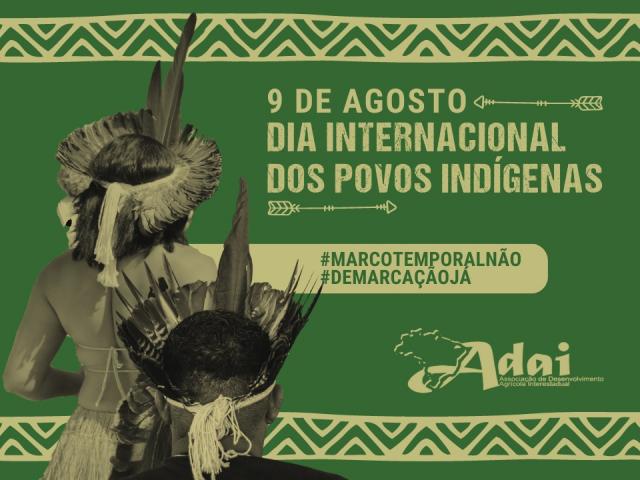August 09 – International Day of Indigenous Peoples

“From the River to the Sea: They won’t shut us up”
The International Day of the World’s Indigenous Peoples was created in 1995 by the United Nations (UN) as a result of the actions of representatives of indigenous peoples from different parts of the world. The day is dedicated to valuing and recognizing traditions and promoting awareness of the inclusion of the Original Peoples of the planet’s various indigenous ethnic groups.
In Brazil, data provided by the Brazilian Institute of Geography and Statistics (Instituto Brasileiro de Geografia e Estatística – IBGE) indicate that in 2023 there will be around 1,652,876 indigenous people, from 305 ethnic groups, who speak 274 languages, consolidating the ethnic and linguistic plurality of the original peoples. In addition, the Indigenous Territories are among the main barriers against the advance of deforestation in the country. According to MapBiomas, in the last 30 years, indigenous lands have lost only 1% of their native vegetation, while private areas have lost 20.6%. In 2020, indigenous lands occupied 13.9% of Brazilian territory and contain 19.5% of Brazil’s native vegetation.
The Original Peoples are in a daily struggle for the demarcation of their territories and the guarantee of their rights. Only in 2023 was the Ministry of Indigenous Peoples established, coordinated by an indigenous woman from the Guajajara People, Sônia.
Indigenous Peoples in Espírito Santo
Until the 18th century, what we know today as the state of Espírito Santo was the ancestral territory of the Tupinikins, Guaranis, Botocudos, Pataxós and Puris peoples, among others. These peoples have historically resisted invasions and genocides caused by the Portuguese colonizers, as well as relations of invisibility, prejudice and stigma. From the 20th century to the present day, they have resisted the imposition of damage caused by large public and private enterprises such as timber extraction, oil, the opening of canals, eucalyptus monoculture, livestock farming, and since 2015, with the pollution by mining tailings from the Fundão dam (Mariana-MG), in the Rio Doce, the main river of production and reproduction of the indigenous community’s ways of life.
Currently, only the Tupinikin and Guarani ethnic groups have territories demarcated by the state. At the mouth of the Rio Doce, since 2010, the community of Areal and Santa Maria, in Linhares, of the Botocudo (Borum) and Tupinikin people has been seeking recognition of their constitutionally recognized original right as an indigenous people.
According to Cacique Carlos Gil, the community is also seeking to be recognized as affected indigenous people, and to have access to a fairer and more comprehensive reparation process: “Our people are a suffering people, who have been fighting for 150 years for the Areal indigenous land process to be homologated. And now this mud from the Mariana dam has affected several chains, our food chain, basic sanitation in every aspect. Not just us, but other ethnic groups too, such as the residents, fishermen who are also being affected at this very moment. We, the Botocudo people, need to have a voice so that we can be homologated on our land,” says the leader.
Temporal framework and the struggle for the right to territory
In May 2023, the Chamber of Deputies approved Bill of Law (PL) 490, a proposal that provides for the application of the time frame in the demarcation of indigenous lands. The bill states that native peoples only have the right to lands that were traditionally occupied by them on the day the Federal Constitution was promulgated, on October 5, 1988. In addition to the discussion in Congress, the time frame for the demarcation of indigenous lands is also on trial at the Federal Supreme Court (STF).
The text allows indigenous people to be expelled from lands they occupy if it cannot be proven that they were there before 1988, and does not authorize people who have already been expelled or forced to leave their places of origin to return to their lands. Processes to demarcate historic indigenous lands, which have dragged on for years, could be suspended.
The temporal milestone represents further oppression of indigenous peoples, as it facilitates access by individuals to the ownership of lands where indigenous peoples live, on lands that have not yet been demarcated, in other words, it legalizes land crimes on lands that belong to indigenous peoples. This means that PL490 strengthens historical violence and interference by allowing areas that should not have ownership to be privatized and commercialized.
The process of demarcating Indigenous Lands must be completed as a matter of urgency, because without territory there is no way of guaranteeing the other rights that make it possible for these diverse peoples to live with dignity and integrate with nature.
International Day of the World’s Indigenous Peoples is more than just a day of struggle and resistance against more than 500 years of violence. It’s a day to reinforce that the rights of native peoples need to be guaranteed and respected.
No to PL 490, no to the Temporal Framework! Demarcation now!

